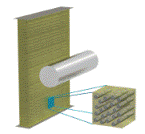Mechanical and Materials Engineering, Department of

Department of Engineering Mechanics: Dissertations, Theses, and Student Research
Date of this Version
Fall 12-2012
Document Type
Dissertation
Abstract
Magnetic resonance elastography (MRE) is a potentially transformative imaging modality allowing local and non-invasive measurement of biological tissue mechanical properties. It uses a specific phase contrast MR pulse sequence to measure induced vibratory motion in soft material, from which material properties can be estimated. Compared to other imaging techniques, MRE is able to detect tissue pathology at early stages by quantifying the changes in tissue stiffness associated with diseases. In an effort to develop the technique and improve its capabilities, two inversion algorithms were written to evaluate viscoelastic properties from the measured displacements fields. The first one was based on a direct algebraic inversion of the differential equation of motion, which decouples under certain simplifying assumptions, and featured a spatio-temporal multi-directional filter. The second one relies on a finite element discretization of the governing equations to perform a direct inversion. Several applications of this technique have also been investigated, including the estimation of mechanical parameters in various gel phantoms and polymers, as well as the use of MRE as a diagnostic tools for brain disorders. In this respect, the particular interest was to investigate traumatic brain injury (TBI), a complex and diverse injury affecting 1.7 million Americans annually. The sensitivity of MRE to TBI was first assessed on excised rat brains subjected to a controlled cortical impact (CCI) injury, before execution of in vivo experiments in mice. MRE was also applied in vivo on mouse models of medulloblastoma tumors and multiple sclerosis. These studies showed the potential of MRE in mapping the brain mechanically and providing non-invasive in vivo imaging markers for neuropathology and pathogenesis of brain diseases. Furthermore, MRE can easily be translatable to clinical settings; thus, while this technique may not be used directly to diagnose different abnormalities in the brain at this time, it may be helpful to detect abnormalities, follow therapies, and trace macroscopic changes that are not seen by conventional methods with clinical relevance.
Adviser: Shadi F. Othman
Included in
Acoustics, Dynamics, and Controls Commons, Applied Mechanics Commons, Bioimaging and Biomedical Optics Commons, Engineering Mechanics Commons, Mechanics of Materials Commons


Comments
A dissertation Presented to the Faculty of The Graduate College at the University of Nebraska In Partial Fulfillment of Requirements For the Degree of Doctor of Philosophy, Major: Mechanical Engineering and Applied Mechanics, Under the Supervision of Professor Shadi F. Othman. Lincoln, Nebraska: December, 2012
Copyright (c) 2012 Thomas Boulet